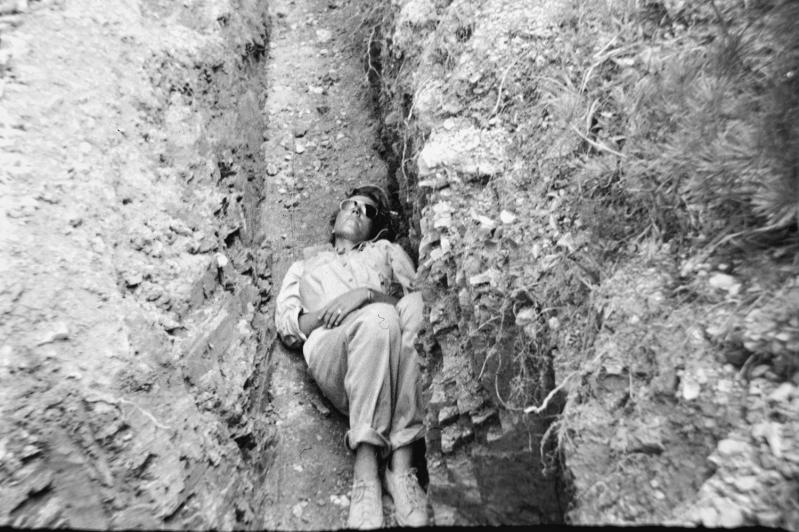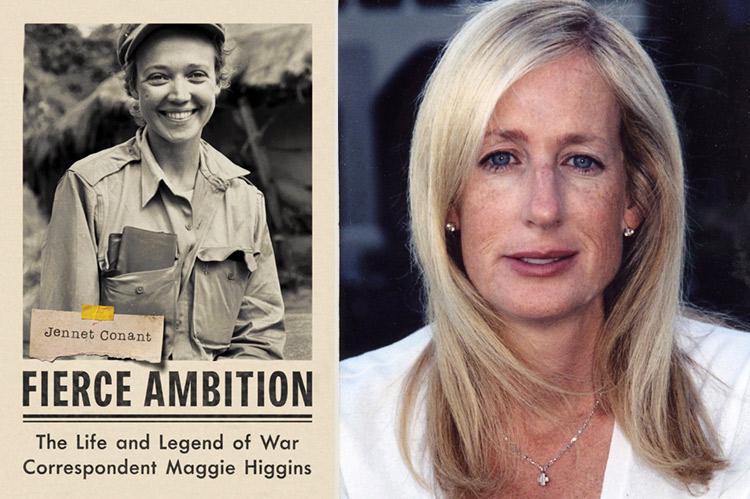“Fierce Ambition”
Jennet Conant
W.W. Norton, $32.50
The opening of Jennet Conant's biography "Fierce Ambition" has the reader riding along in a jeep with Maggie Higgins. April 29, 1945. The 20 miles between the American infantry post and Dachau, the Nazi concentration camp, were unsecured. The American forces were about to roll in. Higgins, a "cub" reporter for The New York Herald Tribune, had gone through extraordinary machinations to get the combat posting, and so many more to find the Stars and Stripes sergeant, Peter Furst, who could take her deep, deeper into the heartlessness of the war.
Along the way Wehrmacht soldiers who saw the Stars and Stripes jeep threw their guns and hand grenades into the back of the vehicle. Most of those marching knew their side had lost. But surely not all of them. Higgins was wearing a heavy German Army jacket and a fur-lined hat to cover her curls. She understood she was a woman in man territory, both literally and figuratively.
In this biography Ms. Conant writes brilliantly about a female journalist who has been, in many ways, ignored by journalistic history. Indeed, this work points out, without ever having to point it out, that female war correspondents have been overlooked or never invited to the war correspondent party. Scanning the number of female World War II correspondents, one sees the names of Martha Gellhorn — a name made famous by her relationship with Ernest Hemingway — and a few others, including Margaret Bourke-White, but Marguerite Higgins? Who knew?

U.S. Army Signal Corps, Courtesy of National Archives and Records Administration
Back to the nail-biting prologue of Ms. Conant's book: Marguerite Higgins and Peter Furst arrived at Dachau to the sound of machine-gun fire. When they arrived, as Higgins wrote, " 'Are you Americans?' in about sixteen languages came from the barracks 200 yards from the gate. An affirmative nod caused pandemonium. Tattered, emaciated men, weeping, yelling and shouting 'Long live America!' swept toward the gate in a mob. Those who could not walk limped or crawled."
Ms. Conant writes: "In the wild outpouring of joy that followed, the prisoners sprinted toward [Higgins], running, falling, tripping, getting up and rushing forward again. One flung his arms around her in an enthusiastic embrace that lifted her off her feet. Another enveloped Furst in a huge bear hug. The ecstatic inmates picked up their liberators and tossed them in the air, hoisting them from shoulder to shoulder and parading them around the camp, too excited to detect a soprano voice of protest rising above their raucous cheers. The atmosphere of hysteria produced unbelievable strength in men who looked too weak to stand, and Maggie was quickly overwhelmed by the welcoming stampede. One man, who had his arms around her neck and was kissing her effusively, heard her cry out that she could not breathe. He hastily disengaged and fended off the others."
" 'Mon Dieu, mon Dieu, c'est une femme!' he exclaimed in French. 'Pardon, madame.' A Catholic priest, and a deputy of August Cardinal Hlond, Primate of Poland, he was deeply chagrined by his mistake."
In the prologue to this book, Ms. Conant quotes Furst: "We did all kinds of crazy things that I never would have done by myself. But you know, you don't want to be shown up by a beautiful young lady." Never mind the language from the mid-20th century: A woman who had to pretend not to be a woman at the end of World War II? Marguerite Higgins was one of the first people liberating Dachau. And today very few people have ever heard of her. Even those who have been journalists their entire career.

U.S. Army Signal Corps, Courtesy of National Archives and Records Administration
In 1951 Higgins was one of six reporters to be awarded the Pulitzer Prize in International Journalism for her work during the Korean War — the only woman in the bunch. In the 1960s she went to Vietnam to cover the war there. She contracted an illness, which would prove fatal. As Ms. Conant reports, Higgins had savored every minute of her own reportorial life. Even whipping off the fur-lined cap, revealing her blond curls.
And yet, and yet . . . what sticks in one's craw in reading this biography is the number of other exceedingly well-regarded male war correspondents who begrudged Higgins's tenaciousness and audaciousness. After World War II. After the Korean War. After the Vietnam War.
Ms. Conant writes: "Wes Gallagher, AP general manager, who had first encountered Higgins in Germany when she was still a young cub, called her death a loss to journalism as a whole. Longtime admirers from Ralph McGill and John Chamberlain to Clare Boothe Luce penned testimonials to her heroic career. 'Maggie was a cross between Alice in Wonderland and Eleanor Roosevelt,' one competitor told Newsweek. 'She regarded the world with wide-eyed excitement. Then rolled up her sleeves determined to do something about it.' "
With this volume, this carefully crafted and conceived investigation of what it meant to be on the front lines and what continues to be meaningful for those giving us the true stories of all that is happening around the world, Jennet Conant has done a huge service to journalists and writers. Including those who happen to be women.
Lou Ann Walker, a professor in Stony Brook University's creative writing and literature M.F.A. program, is executive editor of TSR: The Southampton Review. She lives in Sag Harbor.
Jennet Conant's previous books about World War II include "The Great Secret" and "The Irregulars." She lives part time in Noyac.

